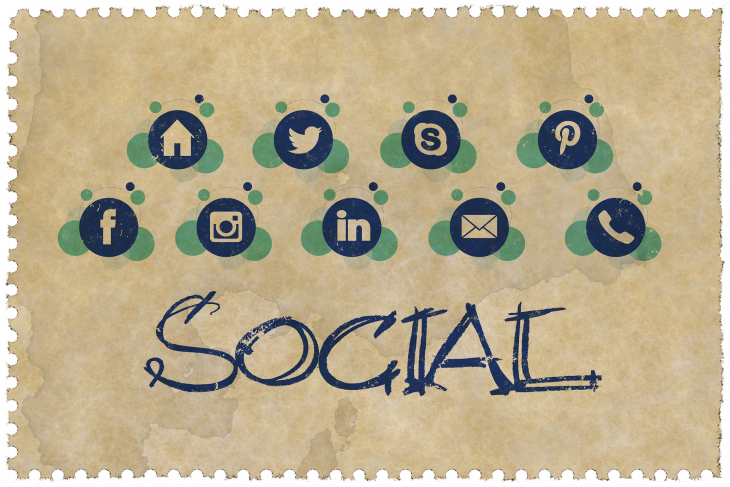If you could put the process of scoring more subscribers on autopilot, would you do it? More leads, more subscribers, less of a “hands-on” approach. Sounds a bit too good to be true, right?
Think again.
The recent rise of marketing automation has taken some serious legwork out of winning new leads. The end result is a marketing strategy that revolves around saving time while also taking some of the most tedious tasks off of your team’s plate.
While embracing marketing automation isn’t as easy as flipping a switch and walking away, there’s a reason why over half of all B2B marketers are already on board.
And you should be, too.
Why Automation Deserves Your Attention
Despite popular belief, the concept of “automation” is no longer a marketing buzzword.
It’s not about machines taking over your marketing strategy, but rather putting systems in place to drive more traffic and build your base of subscribers.
Let’s be honest: lead generation is time-consuming. With so many channels to explore between email, social media and content marketing alone, we need all the help we can get when it comes to winning over new subscribers without losing our minds.
Through automation, you can focus on your strengths as a marketer and let algorithms and machines do the proverbial “dirty work” on your behalf. It’s a win-win situation.
In short, marketing automation is about making your business more efficient rather than handing it over to robots.
9 Proven Automated Marketing Strategies to Try
Effective automation doesn’t happen by accident.
You need to decide which systems you want to put on autopilot and how you’re going to treat your marketing like a well-oiled machine.
The good news? Setting up those systems is arguably easier than ever with all of the tools and strategies available today.
Besides, there’s a good chance that you’re already familiar with automation in some way, shape or form, anyhow.
Below we’ve outlined nine specific marketing automation strategies you can adopt ASAP if your end-game is a most substantial list of subscribers.
With that, let’s dive in.
1. Email Autoresponders
Perhaps the most notable and widespread use of automation comes from the world of email.
Drip campaigns that nurture your leads. Automatic messages that keep subscribers from bouncing out of your funnel. The list goes on and on.
Email autoresponders are a critical piece of marketing automation any brand-hungry for long-term subscribers.
This is especially true if you’re looking to fight the epidemic of shopping cart abandonment, which impacts a staggering three-fourths of potential purchases.
Autoresponders work to keep would-be subscribers engaged when they’d otherwise be tempted to bounce. For example, consider reasons why people abandon their carts in the first place such as unexpected costs or complicated account setup.
Effective autoresponders can engage those same subscribers without fail. Looking at some notable cart abandonment examples like this one from Bonobos, we can see how a simple “Hey, come back” message can work to win over a sale that might otherwise be lost.
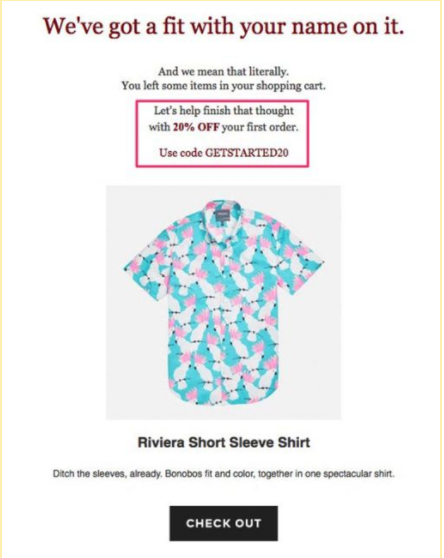
Which types of autoresponders should you have on deck, though? Some standard messages include…
- A welcome autoresponder to introduce your brand on a positive note, including expectations on what benefits your subscribers can look forward to (exclusive information, offers, etc)
- The occasional freebie in the form of a case study, webinar invitation or other exclusive content that demonstrates the value
- Fresh content in the form of blog previews or your company newsletter, both of which can clue subscribers in and keep them active in your funnel
The ability to send these sorts of messages automatically gives businesses peace of mind as they don’t have to worry about chasing lost leads.
2. Retargeted Facebook Ads
Ever heard of the marketing “rule of seven?”
The idea is simple: people need to come across your ads and offers at least seven times before they feel comfortable buying from you. Same rules apply in your pursuit for more subscribers and opt-ins, too.
That’s why Facebook’s custom audiences and retargeting have become staples of modern marketing. Syncing with touchpoints such as site visits, your email list or CRM data, brands can customize Facebook ads specifically for prospects who’ve interacted with them in the past.
Maybe someone checked out a blog post. Perhaps they were in the middle of a purchase and bounced.
Through retargeting, brands can effectively “track” these prospects and customize their Facebook lead ads accordingly.
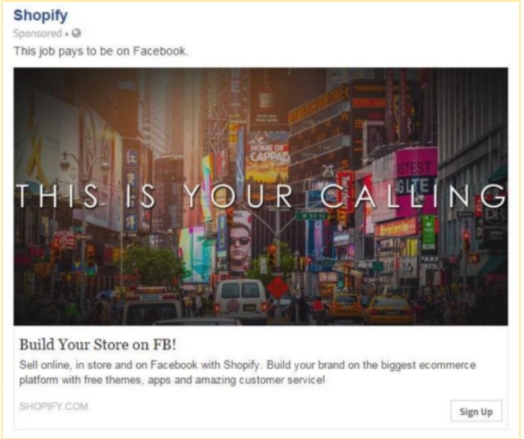
Rather than send out one-size-fits-all marketing, consider how personalized ads increase engagement by nearly 75%.
As Facebook is currently cooling down on branded content, marketers should familiarize themselves with their ad platform sooner rather than later.
Facebook provides three options to get started with retargeting, including any combination of the following to create a custom ad audience:
- Uploading your current customer list (pulled from your email contacts for CRM data)
- Integrating the Facebook Pixel code into your website header to track former and future visitors
- Creating a mobile advertising ID for app users, similar to the previously noted Pixel
Mastering the art of retargeting is a smart move for marketers looking to make the most of automation.
3. Lead Capture Forms
Sometimes the best way to score subscribers is to just ask.
Don’t underestimate the power of popups and lead capture forms. Clean and simple, you can integrate such forms throughout your on-site content (think: blog posts, landing pages) without hurting the user experience.
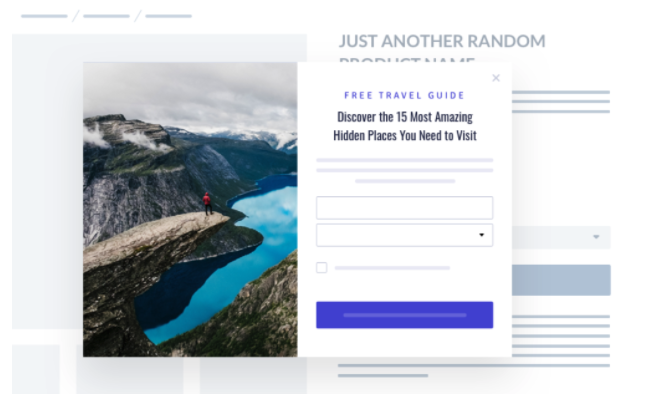
Conventional wisdom tells us that a paltry 2% of leads convert on average. However, brands who seamlessly integrate opt-in opportunities on-site can increase their conversions up to 12%.
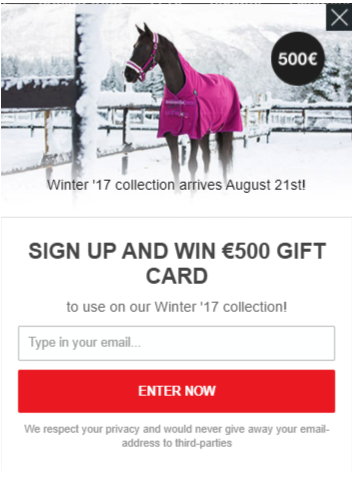
Source: Sleeknote
Again, automation doesn’t have to be inherently complicated.
Lead capture forms can be implemented just about anywhere on-site (think: not just on your homepage).
Some smart spots for capture forms include:
- Your “About Us” page, representing one of any given site’s most visited pages which often lacks any sort of CTA
- Checkout pages, offering an opportunity to sweeten your deals with a freebie or extra value proposition from your email list (free shipping, free webinar, etc)
- Content upgrades within your blog posts, serving as a sort of call-to-action to keep readers engaged with you beyond the initial post
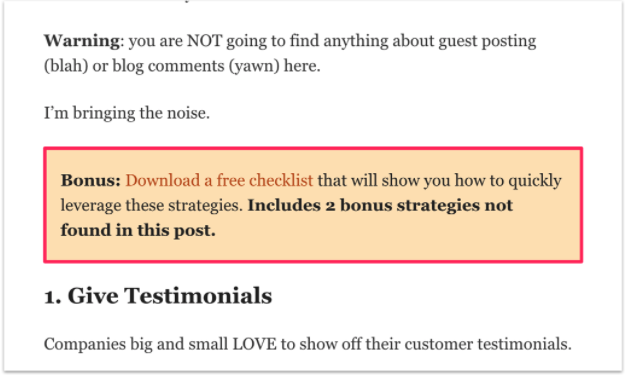
It’s all about creating multiple avenues for subscribers to opt-in automatically. By integrating these opportunities on your site’s most relevant pages, you encourage more conversions without lifting a finger.
4. Social Media Automation
Given there’s a non-zero chance that your prospects are spending time on Facebook at the very least, there’s certainly an expectation for marketers to cover their social bases.
Whether it’s through sharing content or nurturing leads, the likes of Twitter, Instagram and Pinterest are likewise valuable depending on your industry.
But while the majority of marketers are using social media to generate leads, 60% of businesses note the difficulty of assessing their social ROI.
The problem? Time.
It’s easy to sink hours into back-and-forth via social without much in terms of a concrete ROI.
That’s where social automation comes into play.
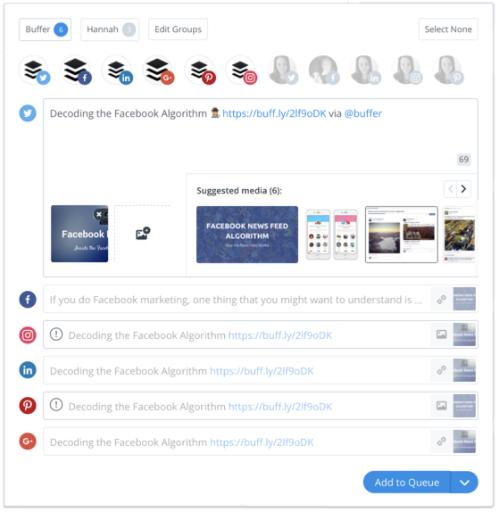
Source: Buffer
From scheduling posts to finding trending tags and topics, brands flat out need a hand when it comes to wrangling their social presence. Below are just a few of the top tools brands use today to do just that:
These tools take away the pressure of having to publish content in real-time and optimize your social schedule for engagement.
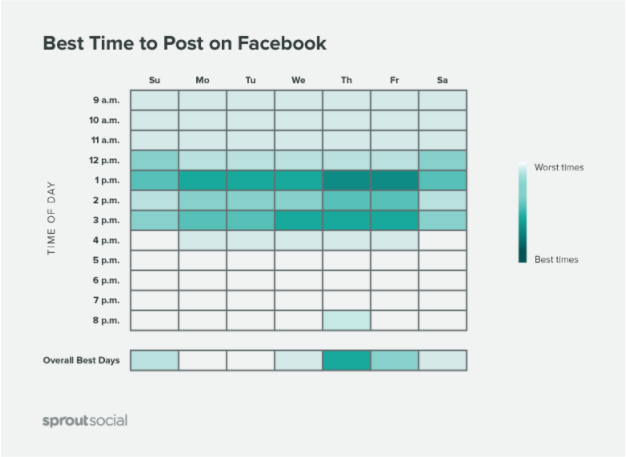
Additionally, as noted by Hootsuite’s own case of publishing the same tweet 45 times, recycling and cross-posting your social content is totally fair game.
As you might notice from Zapier’s Twitter, we heavily promote our former content with fresh descriptions time and time again. After all, the content is still incredibly valuable, but given the fast-paced nature of social, it pays to recycle your content.

Much like lead capture forms, social content sort of serves as a numbers game. The more opportunities you give people to opt-in, the better.
Some strategies to take advantage of social automation through a scheduling app include:
- Queuing up your latest blog post and then recycling it was a new description (think: use a different state or quote to couple with your link)
- Promoting your latest webinars or “claim your spot” offer to get your followers hyped
- Post evergreen tips and inspiration for your followers
By ticking these boxes, you can spend less time worrying about “when” and more time actually communicating with potential subscribers via social.
5. Behavior-Based Email Campaigns
Alright, let’s talk briefly about email once more.
Much like autoresponders, behavior-based emails campaigns are brilliant for segmenting your subscribers and catering to their needs.
The keyword here is “their.” You need to speak directly to individuals via behavioral targeting, not everyone.
If someone spends a bulk of their time engaging with a particular piece of content, they should receive emails based on their activity.
And if someone seems like they’re on the fence about becoming a long-term subscriber, you need to craft specific messages to reel them in.
Here’s a brilliant behavior-based campaign highlighted by Kissmetrics. This Shopify message speaks directly to those who’ve gone through a trial period but perhaps need an extra push to stick around.
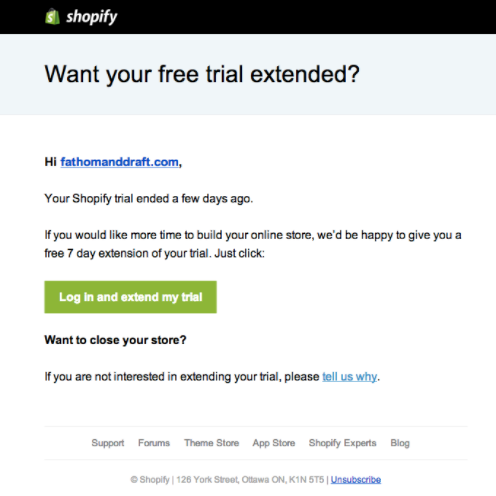
This “icing on the cake” email not only speaks directly to a specific action but also works to recover the recipient’s interest.
6. Lead Magnets
If you want more subscribers, you need some sort of incentive to make it happen.
A generic “Join our list!” message just isn’t enough anymore, especially in a world where 95% of potential buyers will bounce during their first visit to your site.
Lead magnets in the form of webinars, case studies and e-books are all brilliant options depending on your industry. Despite all the tricks in the modern marketing playbook, the power of “free” is still as irresistible as ever.

Source: Sleeknote
Webinars, in particular, are booming right now given the potential for audience interactivity and the sheer popularity of video marketing.
Simply put, your lead magnets need to be compelling and boast a sort of “must see” vibe. They need to feel exclusive, offering some sort of insider or epic information that’s worthy of your subscribers’ email address.

Source: Campaign Monitor
Most people aren’t going to subscribe to your list out of the blue. With an evergreen lead magnet, you not only snag a new subscriber but also understand what they’re interested in as to craft future campaigns.
Someone signs up for a lead magnet about conversion optimization?
Send them a free series about increasing conversions, eventually leading to your paid product.
See how that works?
Oh, and coupled with a strong lead capture form, you increase your likelihood of new subscribers even further.
Lead magnets aren’t just reserved for big brands, either. The variety of webinar platforms (ClickMeeting, Kajabi, etc) out there and free e-book tools such as Canva provide a cost-effective means for marketers to create their own products on a budget.
7. Review Aggregators
Reality check: your subscribers are likely skeptics.
For the sake of standing out from the crowd and building trust, anything you can do to provide social proof to your prospects is a major plus.
People want to see that you have a track record. They want to know that you have satisfied customers and success stories before giving you their full attention.
Arguably the best forms of social proof beyond first-hand case studies are ratings, reviews, and testimonials.
Having these sorts of trust signals plastered on your homepage and up-to-date shows people that you’re the real deal and that people are pleased with have to offer.
While you can always ask for testimonials and positive feedback on your own, consider how platforms such as Yotpo which automatically aggregate reviews and user-generated content on your behalf.
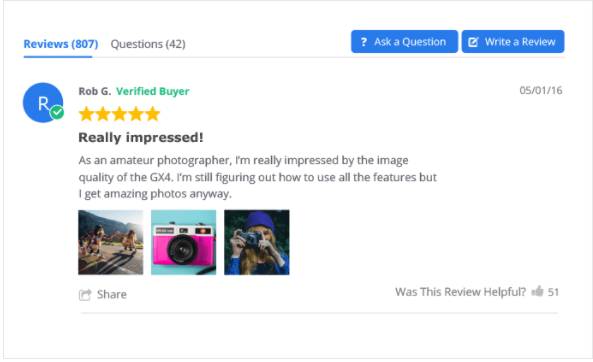
Additionally, review-monitoring dashboards such as Reputology can help you spot social proof in the wild without having to dig for it.
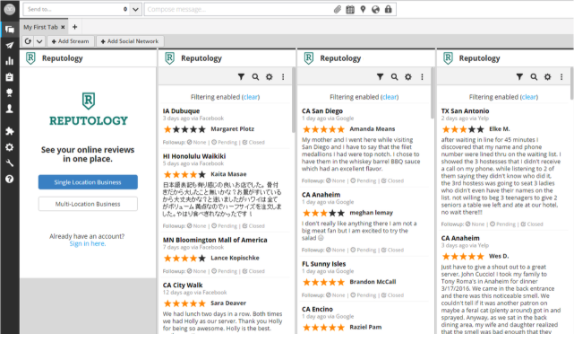
Source: Reputology
What should you do with this social proof, though? Slap it on pages where trust is a must. It’s common to see the homepage or user-generated content on product pages in pursuit of better conversions.
Furthermore, you can use positive reviews throughout your marketing campaigns, double-dipping some of the previous automation tips.
Want to include some testimonials in an email campaign? Receive an awesome message from a customer that you want to share via Twitter?
Go for it.
8. Content Curation and Ideation
Marketers are expected to not only produce their own fresh content on a regular basis but also promote the content of others to their audience. This applies to your newsletters, social channels and blog posts alike.
Of course, ideas can be hard to come by and sifting through relevant, quality content can quickly cut into your schedule.
Not only do you need fresh ideas in a snap, but also buzzworthy pieces your audience will eat up, too.
Whether you’re in need of a content topic or hot article to share around the blogosphere, consider the aggregators and algorithms out there to find the most relevant pieces possible.
Tools such as Buzzsumo can both analyze trending posts based on topic, but also help you double-check that you aren’t copycatting your competition’s content.
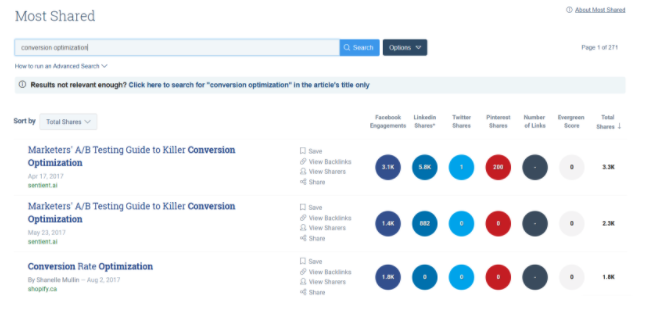
Rather than have to sift through a billion blog posts a day, you have a constant pulse on the topics your followers actually want to hear about.
To take things a step further, services such as Quuu actually suggest hand-picked, reviewed content to help fill up your social feeds.
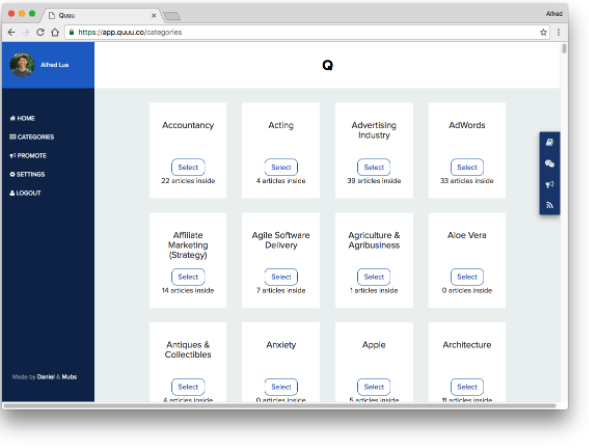
Source: Buffer
This totally removes the manual need to read and frees up one of the most time-consuming aspects of your social presence.
Pretty cool, right?
9. Leverage Your CRM Data
Last but not least, let’s talk about your CRM.
Today’s CRMs are insanely powerful tools for gathering data on your prospects and would-be subscribers.
While there’s plenty we can learn through our CRM fields alone, automation can help us delve beyond surface-level lead data.
For example, consider how services such as Clearbit automatically enrich the data of your leads by dozens of fields, providing you with the deepest possible understanding of your traffic.
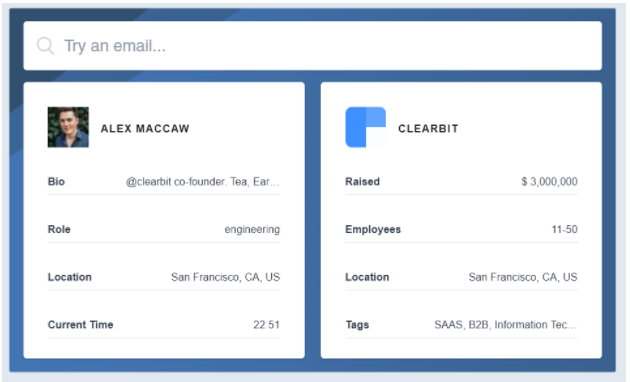
Source: Clearbit
Coupled with the likes of Zapier, marketers can align all of their essential CRM apps so that nothing is lost in translation.
The result is a more comprehensive look at your leads without manually entering every little detail.
This makes life easier for your sales and marketing teams who can stay in-sync with every point of contact, picking up where the last person left off.
What Might Automation Look Like For Your Business?
Don’t assume that marketing automation is out of your grasp.
As detailed by our list, there’s certainly no “right” way to go about putting the various pieces of your marketing on autopilot.
Again, the key is making yourself as accessible to subscribers as possible without sinking all of your time. When these processes are automated, you can focus on nurturing your leads rather than tracking them down 24/7.
And with so many opportunities afforded by automation, hopping on board is becoming more of an expectation rather than an exception to the rule.
